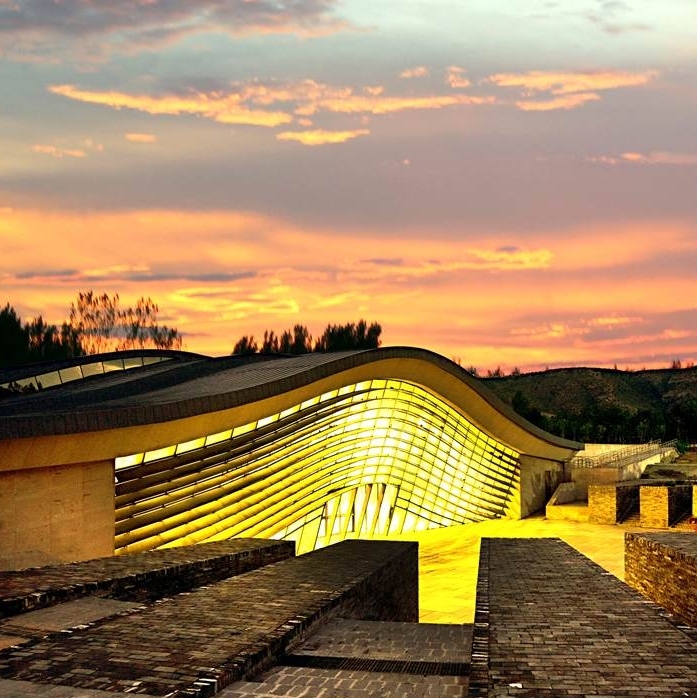The central hall of the museum covers an area of 4,800 m2. At the east end of the front hall sits a scaled restored statue of the Cave 20. Visitors enter the main exhibition hall through the time tunnel; the theme exhibition halls on both sides display cultural relics from the Yungang Grottoes and surrounding areas. The first, second, and third exhibition halls display daily necessities, building components, stone sculptures and unearthed relics of Yungang Grottoes during the Northern Wei Dynasty; rest areas and shops are for tourists to take a break and buy souvenirs of Yungang.
The main function of the museum is to use a unique architectural form and a large number of unearthed cultural relics in the collection to deepen the understanding of Yungang Grottoes and experience the profoundness of Yungang culture.


In the form of multimedia interaction, the images of Yungang, Dunhuang, Longmen, Maijishan, bamiyang and other grottoes are displayed, and the art forms of each grotto are compared.
The three digital houses create a dreamlike world of Buddhism, which is the unique design highlight of the exhibition hall and brings the audience a magical and mysterious visual experience.
"Dream back to Pingcheng", an impressive "image show" in the central exhibition hall, is the core item of the whole exhibition hall to create a digital atmosphere. Through six story chapters of "questioning the Central Plains", "setting the capital of Pingcheng", "Yungang statues", "emperor and empress worshiping Buddha", "Buddha light flashing" and "Shantang Shuidian", the exhibition shows the magnificence and greatness of the excavation process of Yungang Grottoes.
The theme is "art comparison of world Grottoes". In the form of multimedia interaction, the images of Yungang Grottoes, Dunhuang Grottoes, Longmen Grottoes, Maijishan grottoes and Bamiyan grottoes are displayed, and the art forms of each grotto are compared, showing the rich connotation and distinctive grotto art born in the history of world Buddhism.
In the Pingcheng period of the Northern Wei Dynasty, the eastern end of the Silk Road started from the capital Pingcheng. At this time, the Buddhist art in China gradually separated from the influence of the style of Buddhist statues in ancient India and Central Asia, and began to integrate into the artistic characteristics of the Chinese nation.
The Yungang Grottoes of the Northern Wei Dynasty can be divided into three periods: the "tanyao five Grottoes" in the early days of emperor Wencheng were Buddhist works of art with the characteristics of the Northern Wei Dynasty, which were gradually created by local craftsmen and monks on the basis of imitating the western style. In the middle period, the great Grottoes built by the royal family during the period of Empress Dowager Feng and Emperor Xiaowen were mostly double Grottoes in groups, reflecting the further development of Buddhist statue art. In the later period, small caves were excavated by the people after the capital was moved to Luoyang. In particular, the xiuguqing statues in the middle and later period of Yungang show the evolution process of Buddhist statues from "Xiangfa Xilai" to Chinese and secularization.
In northern China at that time, due to the influence of the construction of Pingcheng Grottoes temple, a climax of opening Grottoes was set off, and wuzhoushan Grottoes temple also became a model leading the construction of Grottoes in Northern Dynasties.
In the Pingcheng period of the Northern Wei Dynasty, the wuzhoushan grotto temple, which was built under the leadership of tanyao, is a splendid masterpiece in the history of Chinese Buddhism.
Wuzhoushan Grottoes temple is a Royal Project of the Northern Wei Dynasty, and also a family temple built by the Emperor himself. The new thinking of monks worshiping the Buddha became the magic weapon for the prosperity of Buddhism in the Northern Wei Dynasty. Taiwu emperor's extermination stimulated the rapid development of Buddhism in the Northern Wei Dynasty from the opposite direction, and strengthened the rulers' confidence in rebuilding the Oriental Buddhist holy land. In Wuzhou mountain (Yungang), the famous monk Tan Yao collected monks and translated Buddhist scriptures, marking that Pingcheng has become the Buddhist Center of northern China. With the west wind spreading to the East, Buddhist monks and Han monks gathered in Pingcheng, and craftsmen from Qing, Qi, Liang, Dingzhou and other places gathered to learn from others' strong points, and jointly created Yungang Grottoes, an unparalleled Buddhist paradise.
In the fourth century AD, Xianbei people from the north of China entered the Han territory of the Central Plains one after another. In 398, the capital of the Northern Wei Dynasty was Pingcheng and moved to Luoyang in the 18th year of Taihe (494). During this period, the Northern Wei Dynasty carried out a series of institutional reforms and completed the process of feudalization and Sinicization of Xianbei nationality. Temple architecture and daily necessities are an important part of wuzhoushan (Yungang) grotto temple in Northern Wei Dynasty. In the exhibition, there are mainly architectural components and living utensils unearthed from Yungang, as well as stone carvings and stone coffin beds of the Northern Wei Dynasty, figures and pottery figurines of animals collected from Datong. These objects not only reflect the characteristics of the temple life in Yungang Grottoes at that time, but also confirm the cultural integration and exchange between Han and ethnic minorities.

